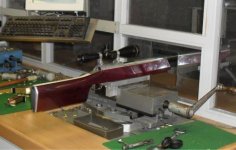Brian,
I shoot my rifle in competition with a tuner on, so I test ammo with the tuner on. I want to see what the ammo will do with the rifle in the configuration that I'll be shooting it. I haven't tested it both ways, but I would not assume the ammo that shot best in a naked barrel would shoot best with a tuner on. It may be the case, but why do all that work to test that theory when I can just leave the tuner on and concentrate on finding the ammo that will shoot well that way. I don't have my gunsmith lop off the non-adustable tuner mass at the end of my sporter to test ammo, I test it with the "tuner" on. I've shot enough great lots of ammo that I know how my rifle should shoot with good ammo. If it doesn't perform, I just keep looking. It has not been all that hard finding lots that my rifles love.
Edgerat, to tune I start off with just a Harrells with no added weight and start with the tuner all the way in and just start shooting and twisting. I pretty much use the Hopewell Method. If the groups are pretty good at the start I'll just turn it out a full turn at a time and then narrow it down to half and then quarter turns. If the groups are not good at the lowest setting, I'll turn it out at least 4 turns and try that etc. If I can't find a spot with the bare tuner, then add weight in the smallest increments I can and keep testing.




